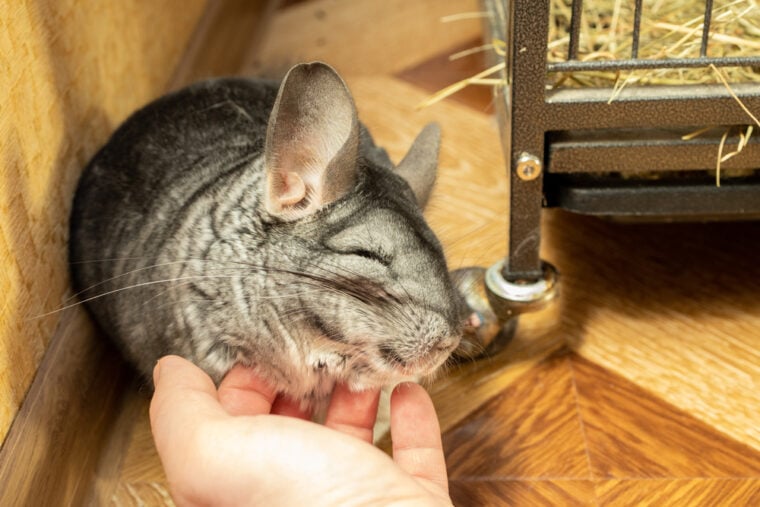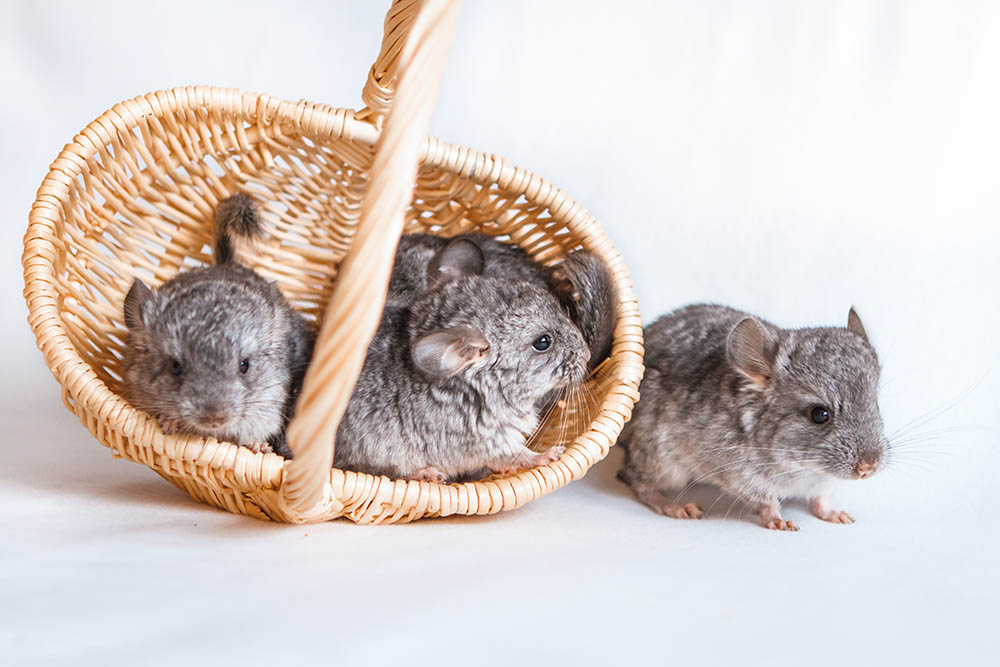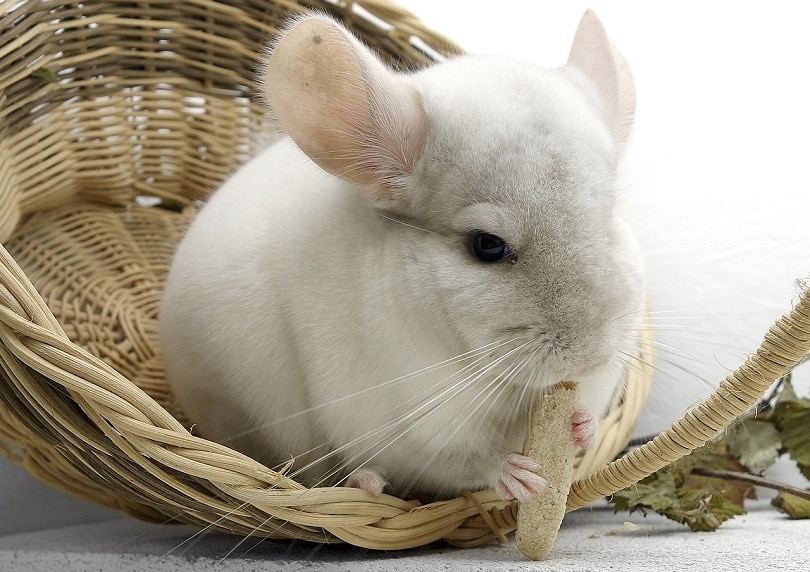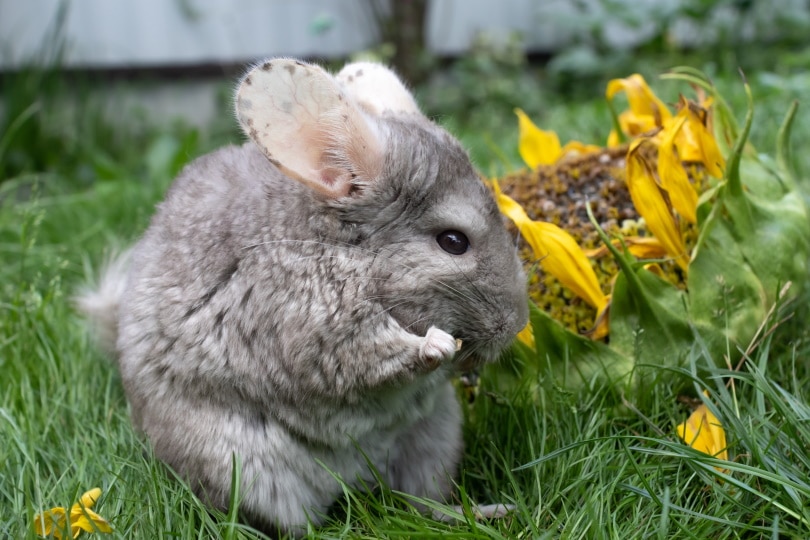
Chinchillas are known and loved for their silky, dense fur and adorable little faces. Their fur is extremely dense, making it irresistible for cuddles and petting. It is so dense each follicle cluster can hold up to 50 hairs! Furthermore, they are great pets for allergy sufferers as they don’t produce as much dander.
Their silky, dense coat is one of the reasons they are irresistible to pet, but a Chinchilla is not a companion that will willingly roll onto its back like a cat for scratches. They tend to prefer their head and back petted.
While affectionate, they are also delicate, so petting should be done cautiously and only when your Chinchilla trusts you. Once you have earned its trust, your Chinchilla will appreciate gentle petting.

Where Do Chinchillas Like to Be Petted?
Chinchillas like to be petted on their head or their back. That is where they feel safe and are less likely to get hurt. Some also love chin rubs, and a few enjoy belly rubs, but most are wary since the belly is a delicate area.
Chinchillas are very fragile creatures because they have flexible ribs that are thin and mainly made of cartilage. A Chinchilla’s ribs can easily bend and put pressure on the internal organs. Furthermore, the ribs could snap and result in a punctured lung.
That is why it is recommended not to hold your Chinchilla too tightly and why children should not hold them. Chinchillas are naturally nervous around humans because of being hunted in the wild. This may explain why they don’t enjoy being picked up initially until they learn you can be trusted. Once they know you can be trusted, they can be very affectionate, and some may even hop into your hands or lap for you to pick them up.

How to Bond with Your Chinchilla
A Chinchilla owner needs to earn and retain a Chinchilla’s trust. It may take a few weeks for a new Chinchilla to get to know its owner and allow the owner to pet or hold it. The best method involves a lot of patience as you slowly earn its trust and visit your Chinchilla at the same time every day. If you break your Chinchilla trust once, it won’t forget, and it will take longer for you to earn its complete trust, so patience and consistency are key.
You should give your Chinchilla time to adjust to its surroundings since the first few days in a new house may be very stressful. When you approach its cage, do so slowly while talking to it in a calm voice. When you are changing water or feeding your Chinchilla in the first few days, don’t attempt to pet it. With time, your Chinchilla will get to know your voice and become more at ease. You will notice this when it approaches the side of the cage when you come into the room.
How to Pick up Your Chinchilla
Like many small pets, Chinchillas may feel afraid when handled roughly. It’s important to learn how to pick up your Chinchilla so that it doesn’t panic or get injured.
Tips for Adults
When adults pick up a Chinchilla, they should gently place one hand under or around the chest and use the hand to support and lift the hind legs. When you have your Chinchilla in your hands, hold it close to your body and keep it upright to protect its delicate spine.
Tips for Children
It is recommended that children shouldn’t pick up Chinchillas because of how delicate they are. It is best for them to interact at the ground level. This can be done by creating a safe area where the Chinchilla can run free. The child should sit on the floor or a low seat and allow the Chinchilla to approach them. This can be done by enticing it with treats. As time passes, the Chinchilla will become more comfortable with the child, and the child can pet it gently on its back or head.

Training Tips
You can sit quietly beside the cage and wait to see if your Chinchilla comes over. If it does, offer a treat or pellet through the bars. When you raise the treat to your Chinchilla’s level with your arm, it will likely run away, but its curiosity will make it come back to your fingers. Your Chinchilla will start to anticipate your visits if you repeat this action at the same time every night.
After a few days of feeding your Chinchilla through the cage, try setting your hand on the cage floor with the palm facing up. Allow your Chinchilla to approach your hand, and don’t attempt to grab or pet it. Once it approaches your hand, it will sniff your fingertips, run away, and return. Reward your Chinchilla for being well-behaved after each session, and it will eventually grow accustomed to being around you to the point that you can hold and pet it.
Keeping You Chinchilla Happy, Healthy, and Safe
You will only get to pet and hold your Chinchilla when it feels safe and happy around you, and that starts with a great home.
Conclusion
While Chinchillas are affectionate, they may be nervous about being petted and held. An owner needs to earn trust first, but once trust is gained, your Chinchilla will appreciate some gentle petting on its head, back, under the chin, and sometimes, but rarely, its belly. Petting your Chinchilla is safer when you don’t hold it because their bodies are very delicate. If you want to hold and pet your Chinchilla, you must first gain its trust and then learn how to hold it safely. A happy and healthy Chinchilla will be more trusting and receptive to petting, so make sure you take the best care of your Chinchilla and provide it with a safe home, quality diet, and lots of love.
Featured Image Credit: Africa Studio, Shutterstock









